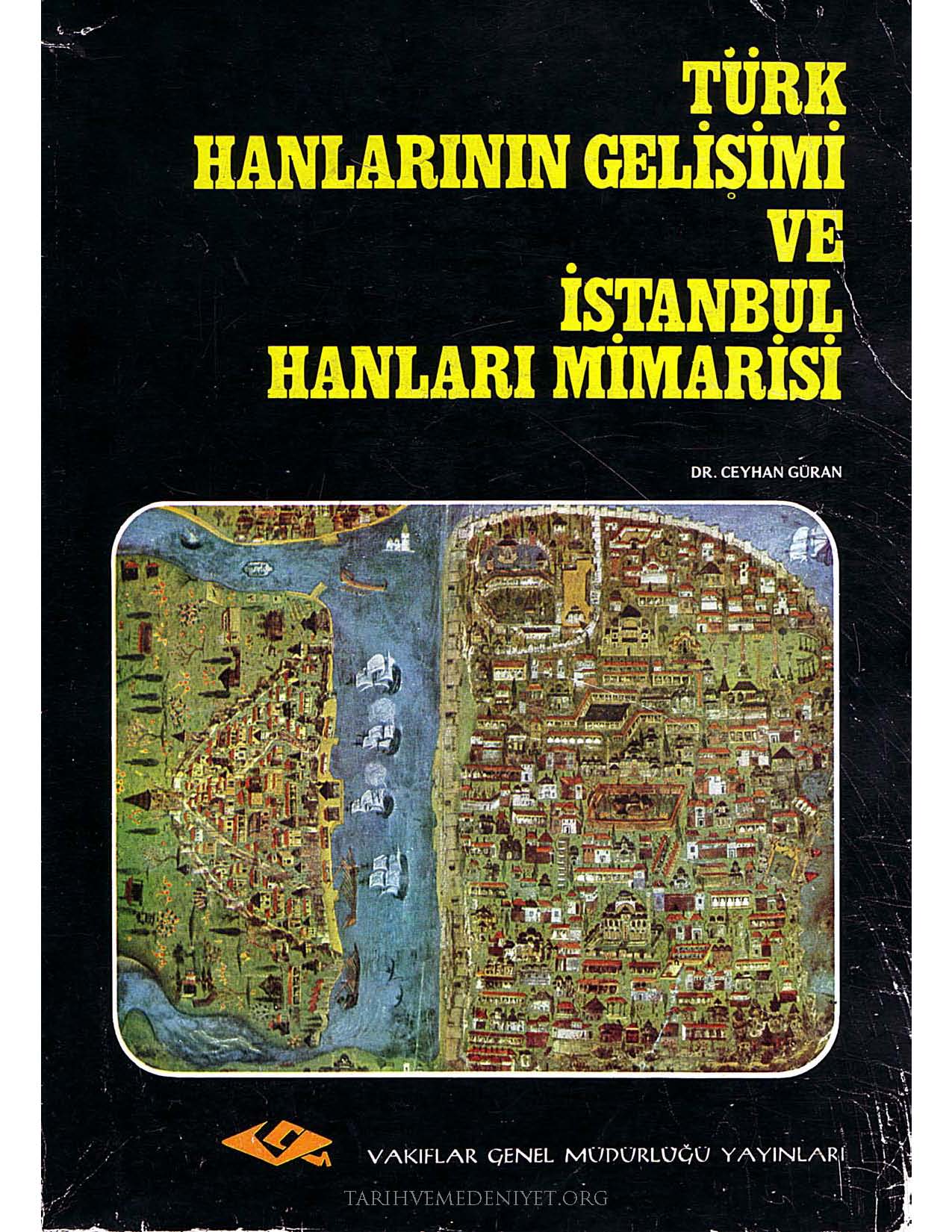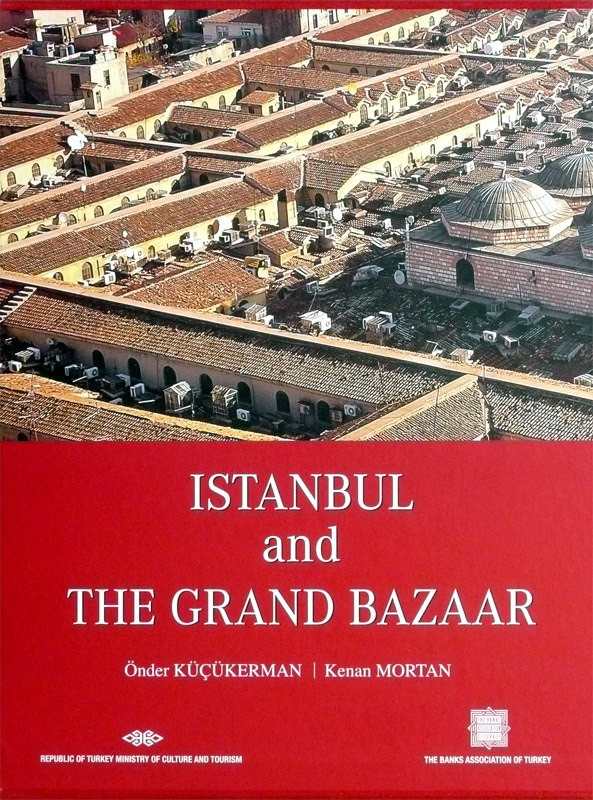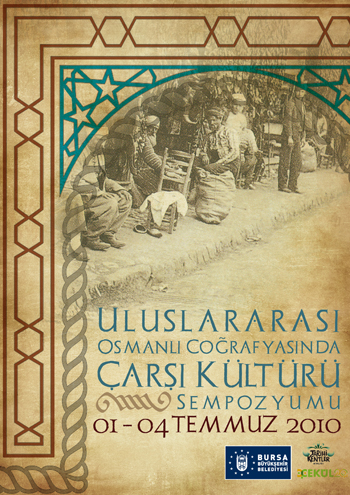Grand Bazaar
Turkish Baths (Hamam)
Book List
-
Cemberlitas Hamami in Istanbul by
Call Number: GT2846.T9 M33 2019ISBN: 9781474434102Publication Date: 2019-02-01Istanbul's �emberlitas Hamami provides a case study for the cultural, social and economic functions of Turkish bathhouses over time. Applies a biographical approach that presents a new paradigm for the discussion of architectural monuments, not only in an Ottoman context, but across time and space. Reconstructs the story of the hamam using architectural surveys, archival documents, media analysis and participant observation. -
Dünden bugüne tarihi İstanbul çarşıları by
Call Number: HF5475.T9 D86 2018Çarşı ve pazarlar han, bedesten, arasta, meydan gibi ister açık ister kapalı şekilde olsun binlerce yıldan beri sosyo-ekonomik hayatın en hareketli ve renkli taraflarını teşkil etmiştir. Hayatımızın bir parçası olan bu çarşıların bazıları cıvıl cıvıl insan kalabalığından geçilmez iken bazıları ise az, fakat kendine mahsus müşterilerini beklemiştir. Çarşılar, toplum hayatına dinamizm veren oluşumlar şeklinde bir vazife görerek şehir hayatında önemli bir yer tutmuşlardır. Türk-İslam kültüründe cami çevresinde oluşan çarşı, medrese, hamam, darüşşifa gibi yapılar bir bütün olarak değerlendirilmelidir. Bunların hepsi hayatın içindeki kurumlar olup yan yana bulunurdu.Türklerin hayatında çarşı-pazar kültürü yarı göçebe yaşantıdan beri binlerce yıldan beri vardı. Ancak Türklerin yerleşik hayata geçişi ve İslamiyet’in kabulü ile birlikte çarşı-pazar kültürü cami çevresinde şekillenmeye başlamıştır. Açık çarşı diye tabir edeceğimiz pazarlar geçici olarak haftada bir ya da daha fazla da olsa yine cami çevresinde kurulmuştur. Kapalı pazarlar ise genelde caminin hemen yanıbaşında camiye gelir sağlamak üzere kurulan vakıf binalarının içinde teşekkül etmiştir. Türklerin İstanbul’u fethi sonrasında şehri bir ticaret ve kültür merkezi yapmak için Fatih Sultan Mehmet, bedestenler yapılmasını istemiştir. Bu bağlamda Cevahir, Sandal ve Galata bedestenleri inşa edilmiştir. Bu bedestenlerden özellikle Cevahir ve Sandal bedestenleri etrafında oluşan dükkanlar şimdilerde Kapalı Çarşı diye tabir ettiğimiz bir ticaret kompleksini doğurmuştur. Osmanlı İstanbul’unda Suriçi, Galata ve Üsküdar bölgesi bir ticaret sitesi iken, Kapalı Çarşı etrafındaki oluşum daha fazla cazibe merkezi haline gelmiştir. Çarşıdan Eminönü-Haliç sahiline kadar olan kısım, Mahmutpaşa’dan Tahtakale güzergahı yüzyıllar içerisinde hanlar ve dükkanların yapıldığı bölge olarak hem İstanbul hem de dünya ticaretinin merkezî yerlerinden birisi olmuştur. Öyleki bu ticaret bölgesinde dünyanın her yerinden (Uzakdoğu’dan, Orta Asya’dan, Afrika’dan, Avrupa’dan) getirilen mallar alınıp satılmıştır. Bu yönüyle çarşı bir Türk çarşısı olmaktan çıkıp uluslararası bir çarşı konumuna sahip olmuştur. Bu çalışmada İstanbul çarşılarından 37 tanesi ele alındı. İstanbul çarşılarına girmeden evvel han, bedesten, arasta, çarşı kavramları üzerinde duruldu. Ardından İslam ve Türk kültüründe çarşı-pazar hayatının gelişimine dair bilgiler verildi. İstanbul çarşılarının sanat tarihi açısından değerlendirmesi yapıldı.Çalışmamızın esas ayağını oluşturan İstanbul çarşılarını Cumhurbaşkanlığı Devlet Arşivleri Başkanlığı’nda(Osmanlı Arşivi Külliyesi) yer alan orijinal belgeler üzerinden değerlendirildi. Ardından her çarşı ile ilgili belgeler ve literatür üzerinden çarşının kuruluşu ile tarihi seyrine dair bilgiler tarihi ve güncel görsellerle zenginleştirildi. Çalışmamız, Osmanlı İstanbul’unun sosyo-ekonomik hayatının aydınlatılmasına katkı sunacağı gibi bir imparatorluk şehri olan İstanbul hayatına, Osmanlı’nın bilinmeyen birçok yönüne dair gizemleri ortaya çıkararak Osmanlı kültüründen bir kesit sunacaktır. -
 Kapalıçarşı = The Covered Bazaar = Le Grand Bazar
Call Number: HF5475.T92 K37 1972
Kapalıçarşı = The Covered Bazaar = Le Grand Bazar
Call Number: HF5475.T92 K37 1972 -
 Typical commercial buildings of the Ottoman classical period and the Ottoman construction system
by
Call Number: NA6275.T9 C49 1983
Typical commercial buildings of the Ottoman classical period and the Ottoman construction system
by
Call Number: NA6275.T9 C49 1983 -
 Türk hanlarının gelişimi ve İstanbul hanları mimarisi
by
Call Number: NA7850.T93 G83 1976
Türk hanlarının gelişimi ve İstanbul hanları mimarisi
by
Call Number: NA7850.T93 G83 1976 -
Bathing Culture of Anatolian Civilizations by
Call Number: GT2846.T9 B37 2011ISBN: 9789042924390Publication Date: 2011-05-18Because of their architectural value and function as places of hygiene, relaxation and interaction, bathhouses have always played a prominent role for civilizations in Anatolia and its neighboring regions. As architectural spaces and important cultural institutions, baths have been continously shaped by social and historical change on many levels and thus constitute a rewarding subject of study for archaeologists and historians in many different sub-fields of the discipline. The outcome of a symposium organized by Koc University's Research Center for Anatolian Civilizations in Istanbul, the essays in this volume examine the evolution of the building type and its cultural context, Seljuk hamams, Ottoman hamams in the capital as well as the provinces of the empire, Safavid and Mughal baths from a comparative perspective, the Turkish bath in the West, and hamams in the painter's imagination. -
 Tipik yapılariyle Osmanlı şehirciliğinde çarşı ve klasik dönem imar sistemi
by
Call Number: NA6275.T9 C492 1985Kitabın adlandırılış biçiminden de anlaşılacağı üzere, ikinci bir konu görüntüsü içinde, eserde, Osmanlı Klasik Dönemi imar sistemi de işlenmiştir. Klasik dönemde şehirlerin kurulup gelişmesinin temelini oluşturan imar sistemi acaba nasıldı? Memleketimizdeki şehircilik araştırmaları, genellikle, şehirlerin şimdiki durumları ile gelecekteki gelişim sorunlarını inceleme şeklinde bir yol izler. Nitekim yayınlanmış şehircilik araştırmalarına bakılırsa, genellikle şimdiki zaman ile gelecek üzerinde durulduğu, geçmişle pek ilgilenilmediği görülecektir.
Tipik yapılariyle Osmanlı şehirciliğinde çarşı ve klasik dönem imar sistemi
by
Call Number: NA6275.T9 C492 1985Kitabın adlandırılış biçiminden de anlaşılacağı üzere, ikinci bir konu görüntüsü içinde, eserde, Osmanlı Klasik Dönemi imar sistemi de işlenmiştir. Klasik dönemde şehirlerin kurulup gelişmesinin temelini oluşturan imar sistemi acaba nasıldı? Memleketimizdeki şehircilik araştırmaları, genellikle, şehirlerin şimdiki durumları ile gelecekteki gelişim sorunlarını inceleme şeklinde bir yol izler. Nitekim yayınlanmış şehircilik araştırmalarına bakılırsa, genellikle şimdiki zaman ile gelecek üzerinde durulduğu, geçmişle pek ilgilenilmediği görülecektir. -
 Istanbul and the Grand Bazaar
by
Call Number: DR739.K36 K8313 2008
Istanbul and the Grand Bazaar
by
Call Number: DR739.K36 K8313 2008 -
 Out of the past : the Istanbul Grand Bazaar
by
Call Number: N5220.B46 A52 1977ISBN: 0668037784Publication Date: 1977-01-01
Out of the past : the Istanbul Grand Bazaar
by
Call Number: N5220.B46 A52 1977ISBN: 0668037784Publication Date: 1977-01-01 -
Osmanlı'da seyahat kültürü kervansaraylar by
Call Number: NA7850.T9 O94 2018Kervansaraylar, askeri ve ekonomik faaliyetlerle kültürel alanın kesiştiği mekanlar olması bakımından önem arz eder. Ticari bir kaygıyla inşa edilmiş bu yapıların, savaş dönemlerinde korunaklı karargahlara dönüştürülebilmesi de, kervansaray inşasına hız kazandırmış ve sayılarının hızla artmasına sebep olmuştur.
Murat Özer, bu çalışmasında kervansaraylarda konaklayan kişilerin, nasıl bir yolculuk sonunda bu yapılara ulaştıkları, geldikleri bu mekanlarda nasıl karşılandıkları, yiyecek ihtiyaçlarını nasıl karşıladıkları, hayvanlarını nerede barındırdıkları gibi pek çok sorunun cevabını bulmaya çalışıyor.
Mimari yapıları dışında pek de bilinmeyen kervansaraylardaki hayatı aydınlatan seyahatnamelerin en şaşırtıcı ve en çarpıcı örneklerini inceliyor ve bu örnekler üzerinden Osmanlı’daki kervansarayların toplumsal hayattaki etkilerine dair önemli sonuçlara varıyor. Böylece seyahatnamelerin, kültür tarihi açısından zengin bir kaynak olduğunun altını çiziyor.
Yazarın gerçekleştirdiği titiz çalışma, Osmanlı toplumunda ticaret, toplumsal hayat ve kültürel karşılaşmalara da,r pek çok konu hakkındaki bilgilerimizi derinleştiriyor.
Osmanlı’da Seyahat Kültürü-Kervansaraylar, Osmanlı’ya ve kültürel yapısına ilgi duyan herkes için temel bir kaynak niteliğinde. Kervansaraylar özelinde çıkılmış bir zaman/mekan yolculuğunun ürünü olan bu önemli eser, yerleşik kalıpları sarsıp tarihe farklı ve yaratıcı bir gözle bakmanın keyfini de okuyucuyla paylaşıyor. -
 Osmanlı Coğrafyasında Uluslararası Çarşı Kültürü ve Sempozyumu, 01 - 04 Temmuz 2010
by
Call Number: HF5475.T9 .O86 2010
Osmanlı Coğrafyasında Uluslararası Çarşı Kültürü ve Sempozyumu, 01 - 04 Temmuz 2010
by
Call Number: HF5475.T9 .O86 2010 -
 Türk taş köprüleri : Ortaçağdan Osmanlı Devri sonuna kadar
by
Call Number: TG111 .C84 1975Fen alemindeki sürekli ilerlemeler yeni imkanlara yol açmaktadır. Eski bir eser, yerini yeni başka yeni bir esere bırakmaktadır. Bu cümleden olarak, tarihî taş köprüler de, betonarme ve çelik köprüler yanında ikinci planda kalmış ve bazıları bakımsızlıktan büsbütün harap olamağa terkedilmiş bulunmaktadırlar. Bununla beraber kendilerinden bugün dahi faydalanılan taş köprüler vardır. Bu eserin amacı, bu tarihî köprülerin bir tarihçesini meydana getirmek, değer ve hatıralarını yaşatmak dileğidir. Eserde köprüler konusu genel olarak ele alınmıştır. Fakat incelemeler daha çok Türk köprüleri üzerinde yoğunlaştırılmıştır.
Türk taş köprüleri : Ortaçağdan Osmanlı Devri sonuna kadar
by
Call Number: TG111 .C84 1975Fen alemindeki sürekli ilerlemeler yeni imkanlara yol açmaktadır. Eski bir eser, yerini yeni başka yeni bir esere bırakmaktadır. Bu cümleden olarak, tarihî taş köprüler de, betonarme ve çelik köprüler yanında ikinci planda kalmış ve bazıları bakımsızlıktan büsbütün harap olamağa terkedilmiş bulunmaktadırlar. Bununla beraber kendilerinden bugün dahi faydalanılan taş köprüler vardır. Bu eserin amacı, bu tarihî köprülerin bir tarihçesini meydana getirmek, değer ve hatıralarını yaşatmak dileğidir. Eserde köprüler konusu genel olarak ele alınmıştır. Fakat incelemeler daha çok Türk köprüleri üzerinde yoğunlaştırılmıştır. -
 Edirne ve Çevresinde Osmanlı Dönemi Askeri Mimari
by
Call Number: NA497.T9 U6 2013Osmanlı Dönemi'nde inşa edilen askeri mimarlık eserleri: Savunma yapıları (kale, sur, kule, siper ve tabya), kışla yapıları, askeri okul, askeri hastane, karargah binaları ile karakol ve silahhaneler gibi yapılardan oluşur. Savunma yapıları hakkında yeterince araştırma yapılmasına karşın karakol, kışla ve karargah binaları Sanat Tarihi bakış açısıyla yeterince incelenmemiştir. Şimdiye kadar Edirne'deki Osmanlı Dönemi'ne ait kışla ve karargah binalarının tamamı hakkında inceleme ve araştırma yapılmamıştır.
Edirne ve Çevresinde Osmanlı Dönemi Askeri Mimari
by
Call Number: NA497.T9 U6 2013Osmanlı Dönemi'nde inşa edilen askeri mimarlık eserleri: Savunma yapıları (kale, sur, kule, siper ve tabya), kışla yapıları, askeri okul, askeri hastane, karargah binaları ile karakol ve silahhaneler gibi yapılardan oluşur. Savunma yapıları hakkında yeterince araştırma yapılmasına karşın karakol, kışla ve karargah binaları Sanat Tarihi bakış açısıyla yeterince incelenmemiştir. Şimdiye kadar Edirne'deki Osmanlı Dönemi'ne ait kışla ve karargah binalarının tamamı hakkında inceleme ve araştırma yapılmamıştır.
19 ve 20.yüzyıllarda batı etkisinde Osmanlı mimarisinin önemli bir bölümünü askeri maksatlı yapılar oluşturur. II. Ordu merkezini oluşturan Edirne'de, Osmanlı Dönemi'nde yoğun imar faaliyetleri görülür. -
 Batılılaşma dönemi İstanbul' unda hanlar ve pasajlar
by
Call Number: DR738.9 .G85 2011
Batılılaşma dönemi İstanbul' unda hanlar ve pasajlar
by
Call Number: DR738.9 .G85 2011 -
 Osmanlı kaleleri : Avrupa'da hudut boyları = Guarding the frontier : Ottoman border forts and garrisons in Europe
by
Call Number: UG430.T9 S74 2007The seventeenth-century Ottoman-Habsburg frontier was the scene of chronic conflict. The defences of both empires were based on a line of fortresses, spanning the border. Mark Stein gives us a fascinating insight into everyday life on the frontier in this turbulent time, by investigating the social, economic and military aspects of Ottoman forts and garrisons in a new comparative approach. Drawing on a wide range of Ottoman and Western archival and narrative sources, Guarding the Frontier assesses the state of early-modern Ottoman military architecture and siegecraft; the Ottomans' ability to besiege, defend, build and repair fortifications in the seventeenth century is carefully dissected, as is the relationship between the central and provisional administrations. With his research into an extensive database compiled from seventeenth-century garrison payment records, Stein has provided an essential addition to the field of Ottoman Studies.
Osmanlı kaleleri : Avrupa'da hudut boyları = Guarding the frontier : Ottoman border forts and garrisons in Europe
by
Call Number: UG430.T9 S74 2007The seventeenth-century Ottoman-Habsburg frontier was the scene of chronic conflict. The defences of both empires were based on a line of fortresses, spanning the border. Mark Stein gives us a fascinating insight into everyday life on the frontier in this turbulent time, by investigating the social, economic and military aspects of Ottoman forts and garrisons in a new comparative approach. Drawing on a wide range of Ottoman and Western archival and narrative sources, Guarding the Frontier assesses the state of early-modern Ottoman military architecture and siegecraft; the Ottomans' ability to besiege, defend, build and repair fortifications in the seventeenth century is carefully dissected, as is the relationship between the central and provisional administrations. With his research into an extensive database compiled from seventeenth-century garrison payment records, Stein has provided an essential addition to the field of Ottoman Studies. -
 Bolu Yıldırım Bayezid Külliyesi hamamlar ve İmaret Camii
by
Call Number: RCAC/NA1371.B6 Y83 1993Elinizdeki bu çalışmada, tarihte mühim bir yer tutan Bolu şehrindeki bazı abideler ele alınarak tetkik edilmiştir.
Bolu Yıldırım Bayezid Külliyesi hamamlar ve İmaret Camii
by
Call Number: RCAC/NA1371.B6 Y83 1993Elinizdeki bu çalışmada, tarihte mühim bir yer tutan Bolu şehrindeki bazı abideler ele alınarak tetkik edilmiştir.
Bunlardan Yıldırım Külliyesi ilk ve mühim tesislerdendir. Fakat günümüzde orijinal haliyle ancak Hamam gelebilmiştir. Yıldırım Bayezid Camii ise Sultan II. Abdülhamid’in emriyle yeniden yapılmıştır. Külliyenin diğer unsurlarından olan Medrese ve Kütüphane’den ise eser kalmamıştır.
Kitaptaki diğer eserler Tabaklar Hamamı, Sultan Hamamı ve Şemsi Ahmed Paşa’nın yaptırdığı İmaret Camii’dir.
Eserlerin yeniden rölöveleri alınarak icap eden restitüsyon denemeleri yapılmıştır. Yeni bazı tarihi bilgiler ve resimlerle monografi çerçevesinde kalınarak okuyucuya tanıtılmaya çalışılmıştır. -
 Anadolu saat kuleleri
by
Call Number: NA2930 .A28 1994
Anadolu saat kuleleri
by
Call Number: NA2930 .A28 1994
